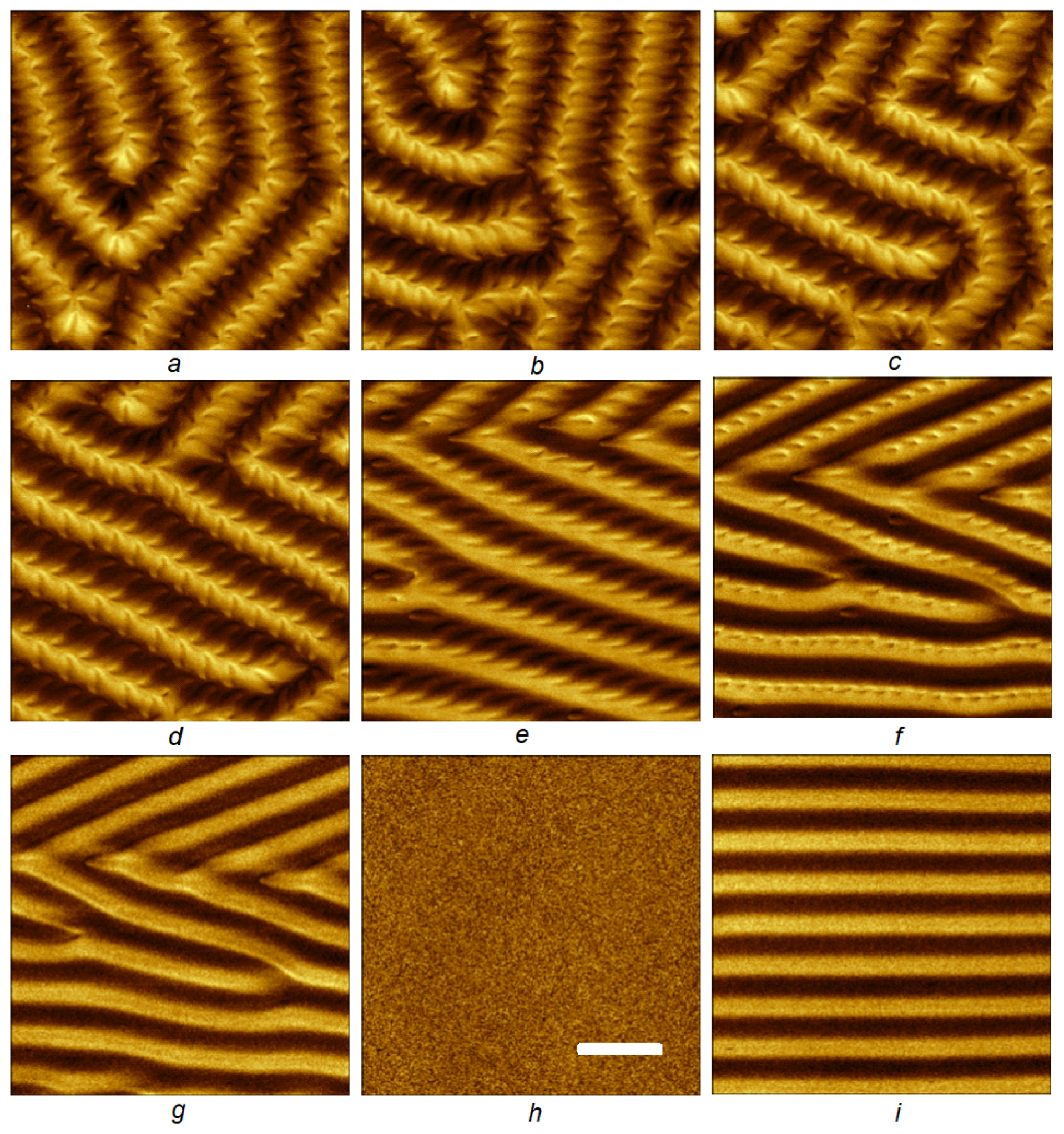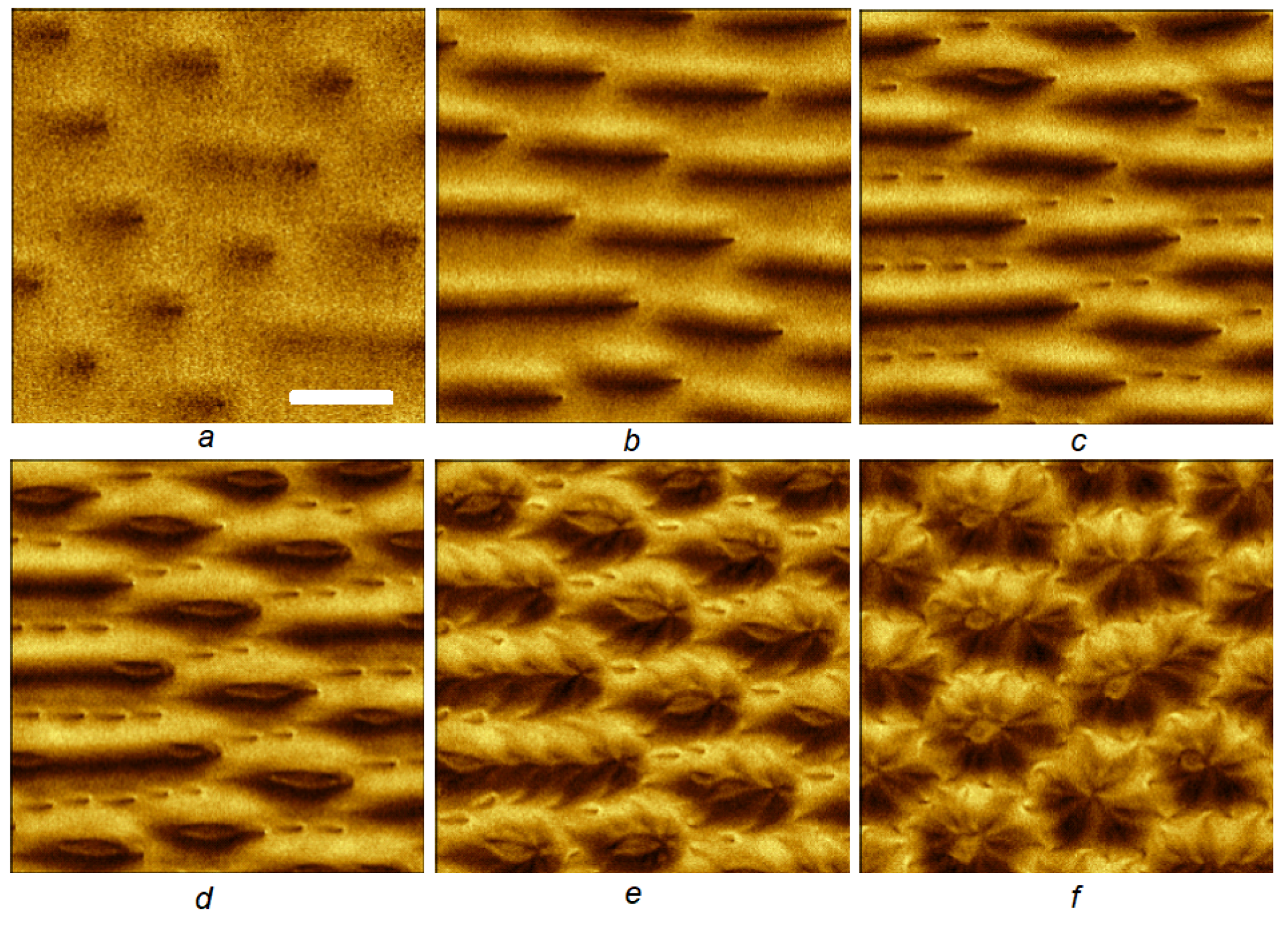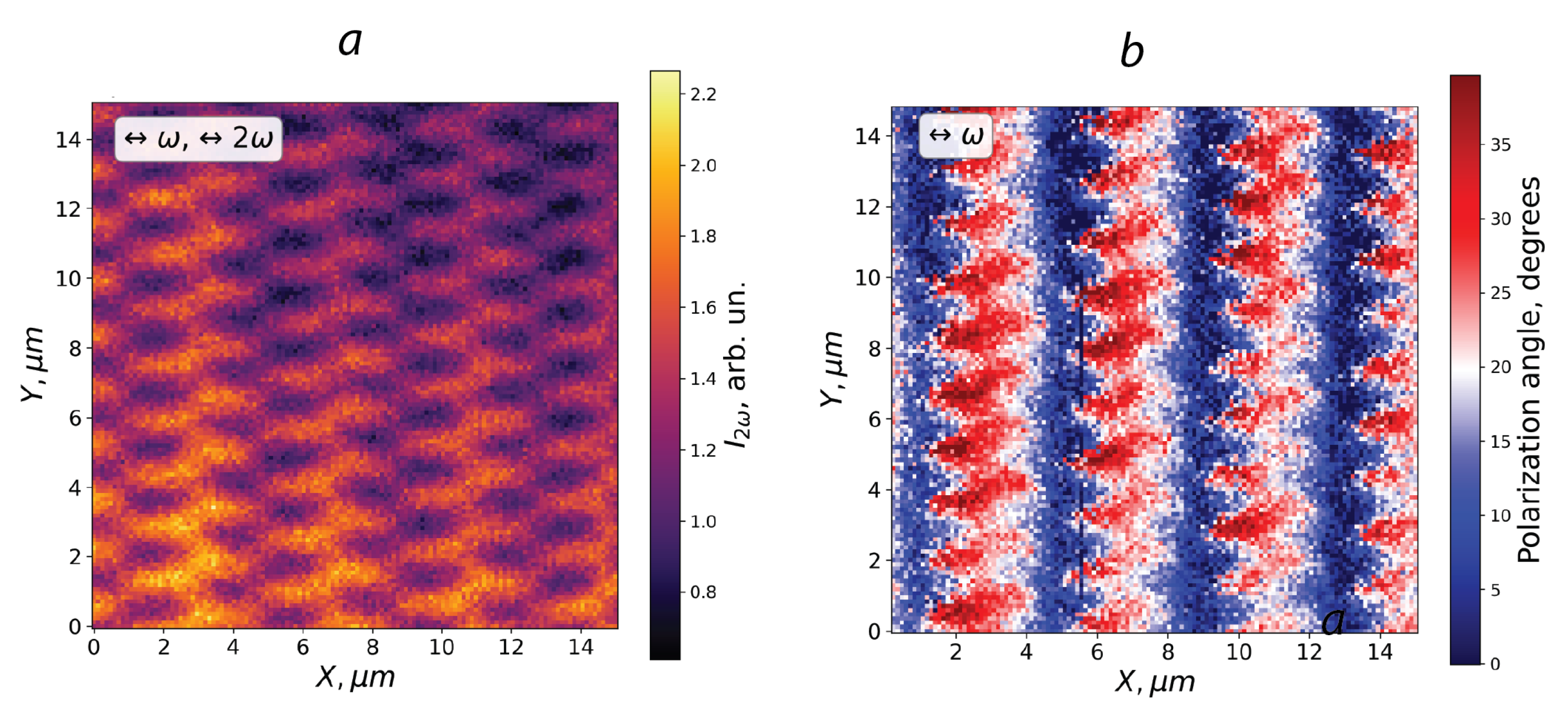Magnetic Domain Structure of Lu2.1Bi0.9Fe5O12 Epitaxial Films Studied by Magnetic Force Microscopy and Optical Second Harmonic Generation
Abstract
:1. Introduction
2. Experimental Procedure and Samples under Study
2.1. Experimental Setups
2.2. Samples
3. Results and Discussion
3.1. Magnetic Force Microscopy
3.2. Second Harmonic Generation Microscopy
4. Conclusions
Supplementary Materials
Author Contributions
Funding
Institutional Review Board Statement
Informed Consent Statement
Data Availability Statement
Acknowledgments
Conflicts of Interest
References
- Alex, H.; Rudolf, S. Magnetic Domains. In The Analysis of Magnetic Microstructures; Springer: Berlin/Heidelberg, Germany, 1998. [Google Scholar]
- Schäfer, R. Magnetic Domains. In Handbook of Magnetism and Magnetic Materials; Coey, J.M.D., Parkin, S.S., Eds.; Springer: Cham, Switzerland, 2021. [Google Scholar]
- Vlasko-Vlasov, V.K.; Dedukh, L.M.; Nikitenko, V.I. Domain structure of yttrium iron garnet single crystals. Sov. Phys. JETP 1976, 44, 1208. [Google Scholar]
- Pamyatnykh, L.A.; Mekhonoshin, D.S.; Pamyatnykh, S.E.; Agafonov, L.; Lysov, M.; Shmatov, G.A. Asymmetry of Domain Walls Oscillations in Iron Garnet Crystals with Stripe Domain Structure Drift in Harmonic and Pulsed Magnetic Fields. Phys. Solid State 2019, 61, 350–360. [Google Scholar] [CrossRef]
- Mendil, J.; Trassin, M.; Bu, Q.; Schaab, J.; Baumgartner, M.; Murer, C.; Dao, P.T.; Vijayakumar, J.; Bracher, D.; Bouillet, C.; et al. Magnetic properties and domain structure of ultrathin yttrium iron garnet/Pt bilayers. Phys. Rev. Mater. 2019, 3, 034403. [Google Scholar] [CrossRef] [Green Version]
- Kulikova, D.P.; Pyatakov, A.P.; Nikolaeva, E.P.; Sergeev, A.S.; Kosykh, T.B.; Pyatakova, Z.A.; Nikolaev, A.V.; Zvezdin, A.K. Nucleation of magnetic bubble domains in iron garnet films by means of an electric probe. Jetp Lett. 2016, 104, 197–200. [Google Scholar]
- Hellman, F.; Hoffmann, A.; Tserkovnyak, Y.; Beach, G.S.D.; Fullerton, E.E.; Leighton, C.; MacDonald, A.H.; Ralph, D.C.; Arena, D.A.; Dürr, H.A.; et al. Interface-induced phenomena in magnetism. Rev. Mod. Phys. 2017, 89, 025006. [Google Scholar] [CrossRef] [Green Version]
- Kumar, P.; Maydykovskiy, A.I.; Levy, M.; Dubrovina, N.V.; Aktsipetrov, O.A. Second harmonic generation study of internallygenerated strain in bismuth-substituted iron garnet films. Optics Express 2010, 18, 1076. [Google Scholar] [CrossRef]
- Pamyatnykh, L.; Lysov, M.; Pamyatnykh, S.; Shmatov, G. Reversal of domain walls drift direction in a low-frequency magnetic field in iron garnet crystals. J. Magn. Magn. Mater. 2022, 542, 168561. [Google Scholar] [CrossRef]
- Zhu, X.D. Magnetic domains and unusual hysteresis loops of yttrium iron garnet crystals revealed by magneto-optic effects’. Aip Adv. 2021, 11, 085214. [Google Scholar] [CrossRef]
- Shen, R. The Principles of Nonlinear Optics; Wiley: New York, NY, USA, 1984. [Google Scholar]
- Pan, R.P.; Wei, H.D.; Shen, Y.R. Optical second harmonic generation from magnetized surfaces. Phys. Rev. B 1989, 39, 1229. [Google Scholar] [CrossRef]
- Mamonov, E.; Kolmychek, I.; Radovskaya, V.; Pashen’kin, I.; Gusev, N.; Maydykovskiy, A.; Temiryazeva, M.; Temiryazev, A.; Murzina, T. Interface Driven Effects in Magnetization-Induced Optical Second Harmonic Generation in Layered Films Composed of Ferromagnetic and Heavy Metals. Materials 2021, 14, 3573. [Google Scholar] [CrossRef] [PubMed]
- Seyler, K.L.; Torre, A.D.; Porter, Z.; Zoghlin, E.; Polski, R.; Nguyen, M.; Nadj-Perge, S.; Wilson, S.D.; Hsieh, D. Spin-orbit-enhanced magnetic surface second-harmonic generation in Sr2Ir O4. Phys. Rev. B 2020, 102, 201113. [Google Scholar] [CrossRef]
- Mochizuki, K.; Sugiura, M.; Yogo, H.; Hu, S.L.J.; Ng, S.H.; Nishijima, Y.; Juodkazis, S.; Sugita, A. Second Harmonic Generation from Phase-Engineered Metasurfaces of Nanoprisms. Micromachines 2020, 11, 848. [Google Scholar] [CrossRef] [PubMed]
- Hristu, R.; Stanciu, S.G.; Dumitru, A.; Eftimie, L.G.; Paun, B.; Tranca, D.E.; Gheorghita, P.; Costache, M.; Stanciu, G.A. PSHG-TISS: A collection of polarization-resolved second harmonic generation microscopy images of fixed tissues. Sci. Data 2022, 9, 376. [Google Scholar] [CrossRef] [PubMed]
- Chen, C.-H.; Nair, A.V.; Chuang, S.-C.; Lin, Y.-S.; Cheng, M.-H.; Lin, C.-Y.; Chang, C.-Y.; Chen, S.-J.; Lien, C.-H. Dual-LC PSHG microscopy for imaging collagen type I and type II gels with pixel-resolution analysis. Biomed. Opt. Express 2021, 12, 3050–3065. [Google Scholar] [CrossRef] [PubMed]
- Hristu, R.; Eftimie, L.G.; Stanciu, S.G.; Tranca, D.E.; Paun, B.; Sajin, M.; Stanciu, G.A. Quantitative second harmonic generation microscopy for the structural characterization of capsular collagen in thyroid neoplasms. Biomed. Opt. Express 2018, 9, 3923–3936. [Google Scholar] [CrossRef]
- Cisek, R.; Joseph, A.; Harvey, M.; Tokarz, D. Polarization-Sensitive Second Harmonic Generation Microscopy for Investigations of Diseased Collagenous Tissues. Front. Phys. 2021, 9, 726996. [Google Scholar] [CrossRef]
- Vollmer, R.; Jin, Q.Y.; Regensburger, H.; Kirschner, J. Second harmonic generation from magnetic surfaces and thin films. J. Magn. Magn. Mater. 1999, 611, 198–199. [Google Scholar] [CrossRef]
- Krutyanskiy, V.L.; Kolmychek, I.A.; Gribkov, B.A.; Karashtin, E.A.; Skorohodov, E.V.; Murzina, T.V. Second harmonic generation in magnetic nanoparticles with vortex magnetic state. Phys. Rev. B 2013, 88, 094424. [Google Scholar] [CrossRef]
- McGilp, J.F.; Carroll, L.; Fleischer, K.; Cunniffe, J.P.; Ryan, S. Magnetic second-harmonic generation from interfaces and nanostructures. J. Magn. Magn. Mater. 2010, 322, 1488. [Google Scholar] [CrossRef]
- Kazakova, O.; Puttock, R.; Barton, C.; Corte-León, H.; Jaafar, M.; Neu, V.; Asenjo, A. Frontiers of magnetic force microscopy. J. Appl. Phys. 2019, 125, 060901. [Google Scholar] [CrossRef]
- Jaafar, M.; Asenjo, A. Unraveling Dissipation-Related Features in Magnetic Imaging by Bimodal Magnetic Force Microscopy. Appl. Sci. 2021, 11, 10507. [Google Scholar] [CrossRef]
- Temiryazev, A.G.; Tikhomirova, M.P.; Fedorov, I. Surface domains in inhomogeneous yttrium iron garnet films. J. Magn. Magn. Mater. 2003, 258, 580. [Google Scholar] [CrossRef]
- Temiryazev, A.G.; Saunin, S.A.; Sizov, V.E.; Temiryazeva, M.P. Magnetic force microscopy study of domain structures in magnetic films. Bull. Russ. Acad. Sci. (Phys.) 2014, 78, 49. [Google Scholar] [CrossRef]
- Zdoroveyshchev, A.V.; Vikhrova, O.V.; Demina, P.B.; Dorokhin, M.V.; Kudrin, A.V.; Temiryazev, A.G.; Temiryazeva, M.P. Magneto-Optical and Micromagnetic Properties of Ferromagnet/Heavy Metal Thin Film Structures. Int. J. Nanosci. 2019, 18, 1940019. [Google Scholar] [CrossRef]
- Mitetelo, N.; Popov, M.; Mamonov, E.; Maydykovskiy, A.; Venkatakrishnarao, D.; Ravi, J.; Chandrasekar, R.; Murzina, T. Chirality driven effects in multiphoton excited whispering gallery mode microresonators prepared by a self-assembly technique. Laser Phys. Lett. 2020, 17, 036201. [Google Scholar] [CrossRef]
- Zvezdin, A.K.; Kotov, V.A. Modern Magnetooptics and Magnetooptical Materials; CRC Press: Boca Raton, FL, USA, 1997; p. 404. [Google Scholar]
- Dikshtein, I.E.; Lisovskii, F.V.; Mansvetova, E.G.; Tarasenko, V.V. Magnetic dislocations in a stripe domain structure. J. Exp. Teor. Phys. 1990, 71, 1213. [Google Scholar]
- Lisovskii, F.V.; Mansvetova, E.G.; Temiryazeva, M.P.; Temiryazev, A.G. Study of the branching domain structures in epitaxial films of yttrium iron garnet by end face magnetic force microscopy. Jetp Lett. 2013, 96, 596. [Google Scholar] [CrossRef]
- Temiryazev, A.G.; Tikhomirova, M.P.; Zilberman, P.E. Exchange spin waves in nonuniform yttrium-iron-garnet films. J. Appl. Phys. 1994, 76, 5586. [Google Scholar] [CrossRef]
- Zilberman, P.E.; Temiryazev, A.G.; Tikhomirova, M.P. Excitation and dispersion of exchange spin-waves in yttrium garnet films. J. Exp. Teor. Phys. 1995, 108, 281. [Google Scholar]
- Kirilyuk, V.; Kirilyuk, A.; Rasing, T. A combined nonlinear and linear magneto-optical microscopy. Appl. Phys. Lett. 1997, 70, 2306. [Google Scholar] [CrossRef] [Green Version]
- Mamonov, E.A.; Maydykovskiy, A.I.; Kolmychek, I.A.; Magnitskiy, S.A.; Murzina, T.V. Polarization-resolved second harmonic generation microscopy of chiral G-shaped metamaterials. Phys. Rev. B 2017, 96, 075408. [Google Scholar] [CrossRef] [Green Version]
- Cheong, S.W.; Fiebig, M.; Wu, W.; Chapon, L.; Kiryukhin, V. Seeing is believing: Visualization of antiferromagnetic domains. Npj Quantum Mater. 2020, 5, 3. [Google Scholar] [CrossRef] [Green Version]
- Petukhov, A.V.; Lyubchanskii, I.L.; Rasing, T. Theory of nonlinear magneto-optical imaging of magnetic domains and domain walls. Phys. Rev. B 1997, 56, 2680. [Google Scholar] [CrossRef]





Publisher’s Note: MDPI stays neutral with regard to jurisdictional claims in published maps and institutional affiliations. |
© 2022 by the authors. Licensee MDPI, Basel, Switzerland. This article is an open access article distributed under the terms and conditions of the Creative Commons Attribution (CC BY) license (https://creativecommons.org/licenses/by/4.0/).
Share and Cite
Temiryazeva, M.; Mamonov, E.; Maydykovskiy, A.; Temiryazev, A.; Murzina, T. Magnetic Domain Structure of Lu2.1Bi0.9Fe5O12 Epitaxial Films Studied by Magnetic Force Microscopy and Optical Second Harmonic Generation. Magnetochemistry 2022, 8, 180. https://doi.org/10.3390/magnetochemistry8120180
Temiryazeva M, Mamonov E, Maydykovskiy A, Temiryazev A, Murzina T. Magnetic Domain Structure of Lu2.1Bi0.9Fe5O12 Epitaxial Films Studied by Magnetic Force Microscopy and Optical Second Harmonic Generation. Magnetochemistry. 2022; 8(12):180. https://doi.org/10.3390/magnetochemistry8120180
Chicago/Turabian StyleTemiryazeva, Marina, Evgeny Mamonov, Anton Maydykovskiy, Alexei Temiryazev, and Tatiana Murzina. 2022. "Magnetic Domain Structure of Lu2.1Bi0.9Fe5O12 Epitaxial Films Studied by Magnetic Force Microscopy and Optical Second Harmonic Generation" Magnetochemistry 8, no. 12: 180. https://doi.org/10.3390/magnetochemistry8120180





